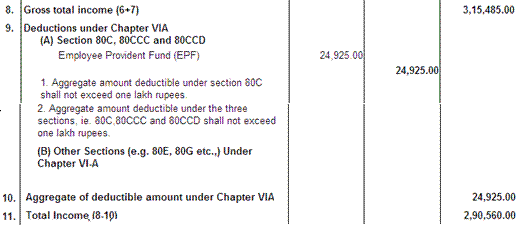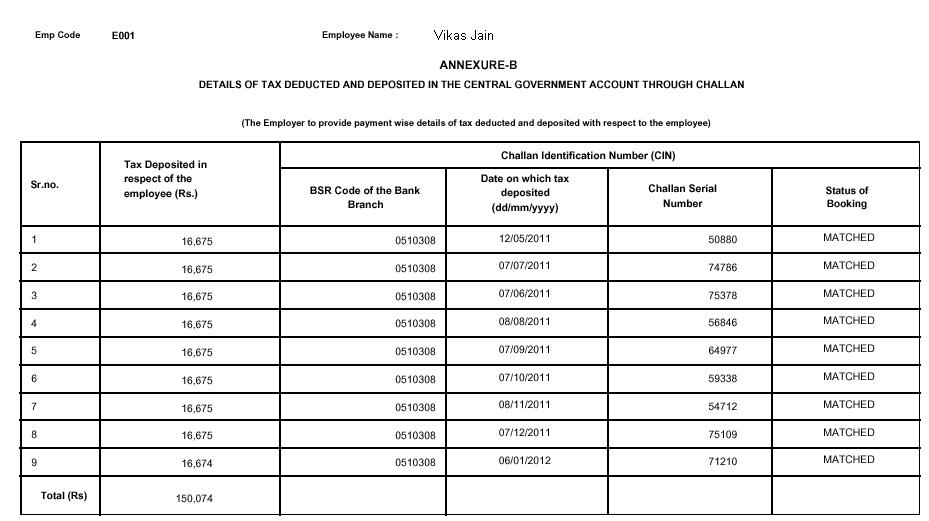In our earlier article Understanding Form 16: Part I and Understanding Form 16: Chapter VI-A Deductions we had found the Employee’s taxable income after deductions from Gross Salary and adding income from other sources. In this article we shall understand the part of Form 16 which deals with Tax on the taxable salary and Tax deducted at Source.
Table of Contents
Finding Taxable Income:Recap of Form 16
Form 16 contains information of employer and employee (like name and address of employer, PAN/TAN of deductor, name and designation of employee, PAN of employee). Besides, one has to disclose, assessment year, period of employment, address of CIT (TDS) and summary of tax deduction at source (like quarter wise information of receipt numbers of original quarterly TDS returns in Form No. 24Q, amount of tax deducted and amount of tax deposited or remitted) explained in detail in Understanding Form 16: Part I.
We had seen in Understanding Form 16: Part I that Form 16 shows’s employee’s Gross Salary with Perquisites and Profit in Lieu of Salary.
From the Gross Salary deductions under Section 10 of income tax (such as Conveyance Allowance) and Deductions such as Tax on Employment , Entertainment allowance employee’s Income chargeable under the Head ‘Salaries’ is found as explained in Understanding Form 16: Part I
To the income under Head Salaries, Income from other sources may be reported by employee. Under Section 192(2B) and Rule 26B of Income Tax Act, When an employee also has any income (not being a loss) for the same financial year, chargeable under any other head(such income from Capital Gain, Income from other sources), he may furnish the statement of such other income and any tax deducted thereon to his employer to take them into consideration while deducting tax from his salary. Adding the other income to income under Head Salaries one gets Gross Salary of employee. Remember Gross Salary is the amount of salary paid after adding all benefits and allowances and before deducting any tax. Explained in detail in Understanding Form 16: Part I
Govt. of India in its Income Tax Act, 1961 has provided a provision of saving income tax by investing in some investment products and also expenditures like medical premiums, education loan etc. These deductions detailed in chapter VIA of the Income Tax Act must be distinguished from the exemptions provides in Section 10 of the Act. While the deductions in Section 10 are to be reduced are part of employee’s income, the chapter VIA deductions do not form part of the income at all, they are to encourage long term savings and specific expenditure. Chapter VI-A of income tax act is about DEDUCTIONS TO BE MADE IN COMPUTING TOTAL INCOME. It specifies the sections from 80A to 80U under which deductions are allowed to be deducted from the assessee’s gross total income. Different sections are applicable to different kind of assesses. Understanding Form 16: Chapter VI-A explains the deductions in detail.
Calculating Tax
After employee’s taxable income is calculated, Everyone whose income exceeds the amount which is not chargeable to the income tax, is an assesse. Assesse is chargeable income tax at the rate prescribed under the finance act for the relevant assessment year. Income tax also depends on assesses’s Type ex Individual, Hindu Undivided Family (HUF), Firm, Trust etc. For an individual it depends on
- Gender (male or female),
- Age (senior citizen between 60 years to 80 years, women below the age of 60 years ) ,
- Residential status.
For the income earned between 1 Apr 2011 to 31st Mar 2012, the financial year is 2011-12 and Assessment year(AY) is 2012-13.
For a resident Indian individual for the Assessment Year 2012-2013 the income tax slabs are as follows:
| TAX | MEN | WOMEN | SENIOR CITIZEN(60 – 80 yrs) | Very Senior Citizens(Above 80 years) |
| Basic Exemption | 180000 | 190000 | 250000 | 500000 |
| 10% tax | 180001 to 500000 | 190001 to 500000 | 250001 to 500000 | – |
| 20% tax | 500001 to 800000 | 500001 to 800000 | 500001 to 800000 | 500001 to 800000 |
| 30% tax | above 800000 | above 800000 | above 800000 | above 800000 |
| Surcharge | No surcharge in the case of individual, Hindu undivided family, Association of persons and body of individuals | |||
| Education Cess | 3% on Income-tax | |||
For income tax rates of earlier years checkout our Income Tax rates Since AY 1992-1993 For every income minimum amount (called as exemption limit is deducted). For Assessment Year (AY) 2012-13 the exemption limit is Rs 1,80,000(One lakh eight thousand). So tax computation for indian male less than 60 years is as follows:
| Level of income | Tax |
| 1. Where the total income does not exceed Rs. 1,80,000/-. | Nil |
| 2. Where the total income exceeds Rs. 1,80,000 but does not exceed Rs. 5,00,000/- | 10 per cent of the amount by which the total income exceeds Rs. 1,80,000/- |
| 3. Where the total income exceeds Rs. 5,00,000/- but does not exceed Rs. 8,00,000/-. | Rs. 32,000/- plus 20 per cent of the amount by which the total income exceeds Rs. 5,00,000/-. |
| 4. Where the total income exceeds Rs. 8,00,000/-. | Rs. 92,000/- plus 30 per cent of the amount by which the total income exceeds Rs. 8,00,000/-. |
In the above example Total income of the employee comes out to be 2,90,560. Assuming the employee as Male and less than 60 years of age, as the taxable income is between 1,80,001 to 5,00,000 for men he will be taxed at 10%. So Tax would come out to be
| Description | Amount | Income Tax |
| Exempt Income | 180000 | 0 |
| Income chargeable at 10% | 110560 | 11056 |
| Total | 290560 | 11056 |
To the tax calculated Surcharge and Education cess are added.
Surcharge, Education cess
Surcharge: Surcharge means An additional charge or payment. It’s like an extra fee added onto another fee or charge for ex:
- fuel surcharge which represents additions due to jet fuel prices.
- sea freight charges which represents additions due to oil prices.
- surcharge (payment systems) charged when paying with cheque, credit, charge or debit card
In relation to Indian Income Tax, surcharge is the extra tax levied on people with higher incomes. For example in For Financial year 2007-08 or Assessment Year 2008-09 10% was charged on taxable income if income was above 10 lakh. Surcharge has been abolished for Personal income tax since the financial year 2009-10. Income Tax rates Since AY 1992-1993 shows surcharge for Assessment years since 1992-93. As income tax law keep on changing and we are not sure when the Finance minister will reintroduce surcharge, you would still find surcharge being mentioned in income tax calculations.
Education cess is a contribution made towards the Secondary and Higher Education development in the economy. All taxes in India are subject to an education cess, which is 3% of the total tax payable. Please note it is not 3% on the income tax but on the income tax payable. So for above example education cess will be calculated on 11,056 and not 2,90,560
| Description | Amount | Income Tax |
| Exempt Income | 180000 | 0 |
| Income chargeable at 10% | 110560 | 11056 |
| Total | 290560 | 11056 |
| Surcharge Nil | 0 | 11056 |
| Education Cess @ 3% of Income Tax Payable | 332 | 11388 |
| Total tax | 11388 |
Relief under Section 89
Relief under section 89 of Indian Income Tax Act is one of the important tax rebate to salaried employee. It deals with taxation on salary when the salary is paid in arrears or in advance. Government employees often get high salary because of arrears. The technical description is at law.incometaxindia.gov.in:Section 89 and calculation is explained in taxexpert13:Relief Under section 89 of Indian Income Tax 1962. In the above example Relief under section 89 is 0(nil). The part of Form 16 for example is given below.
Verification
Every Form 16 has verification from the finance department as shown in the picture below.
Annexure-A, Annexure-B
Along with Form 16 employee also gets Annexure A or Annexure B depending on employer type, also called as Deductor type as employer is the one who deducts tax from the employee salary.Annexure has Details Of Tax Deducted And Deposited In The Central Government Account Through Challan.
- Annexure A if the Employer/Deductor is Government
- Annexure B if the Employer/Deductor Type is Others
Sample Annexure B is shown below:
FinoTax calculator for income tax is worth looking at. It gives the breakup, education cess etc.
Related Articles
- Understanding Form 16: Part I
- Understanding Form 16: Chapter VI-A
- Income Tax Overview
- Basics of Tax Deducted at Source or TDS
- Salary, Net Salary, Gross Salary, Cost to Company: What is the difference
We have tried to explain about Form 16 in simple terms. Hope it was of help to you. For any clarification, feedback or doubts please leave the comment and we shall try to answer it.













which is taxable – Income Chargeable under the head ‘Salaries’ or Gross total income
You need to fill in Income Chargeable under the head ‘Salaries’ (pt 6 in Form 16) as Income from Salary. Our article How To Fill Salary Details in ITR2, ITR1 discusses it in detail.
Very relevant article Kirti Especially at a time one most of us have to file our tax returns. Thank you…
Especially at a time one most of us have to file our tax returns. Thank you…
Thanks a lot Aparna for encouraging words. Yup it’s taxing time and sadly no one teaches us about Form 16!